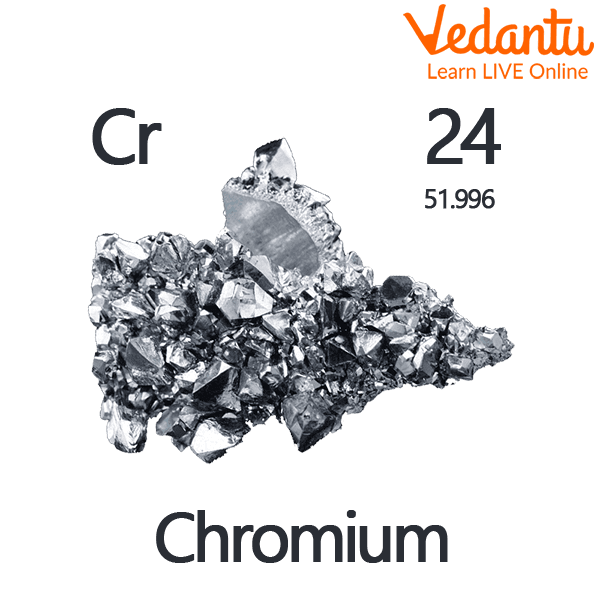




An Overview of Chromium
Chromium is a chemical element with the atomic number 24. The word chromium has been derived from a Greek word ‘chroma’ which means colour. Chromium element has 24 protons and electrons and 28 neutrons. Chromium is a silver-grey metal that is lustrous and hard. It has an extremely high melting point.
In this article, we will explain the physical and chemical properties of chromium, the uses of chromium elements, and facts about chromium in detail.
Occurence and Symbol of Chromium
In the crust of the Earth, chromium is the 21st most prevalent element. Chromium compounds can be redistributed by volcanic eruptions and are found in the environment as a result of the erosion of chromium-containing rocks. Chromium is mostly found in chromite. This ore can be found in a variety of locations, including South Africa, India, Kazakhstan, and Turkey. It is not found in the free state in nature. The element chromium is represented as “Cr”. The atomic mass of chromium is 51.9961 amu.

The Element Chromium
Atomic Mass and Atomic Weight of Chromium
Atomic mass is the measure of the mass of a single atom or isotope. The average mass of an element in relation to all of its isotopes and their relative abundances is known as its atomic weight though the atomic mass and atomic weight of chromium is 51.996u.
Physical and Chemical Properties of Chromium
The physical and chemical properties of chromium are listed below:
Chromium is a lustrous steely-grey metal that is brittle and hard.
Chromium is solid at room temperature.
It is highly corrosion resistant.
When heated, it burns and forms green chromic oxide, which does not tarnish in air.
Chromium has a relatively low melting point of 1907 °C (3465 °F) when compared to the majority of transition metals.
Chromium has a boiling point of 4,840 °F (2,671 °C).
Uses of Chromium Element
Unalloyed chromium's high hardness and corrosion resistance make it a reliable metal for surface coating; it is still the most popular metal for sheet coating due to its above-average durability when compared to other coating metals.
A trace amount of chromium can be found in the crystal lattice structure of valuable gems such as emeralds.
Magnetic tape is produced using chromium (IV) oxide (CrO2).
Chrome plating, a thin layer of metal used for decoration and corrosion resistance, contains chromium.
Chromium is also used in metal ceramics.
Chromium is used as a catalyst.
Green, purple, red, and orange pigments made of chromium compounds are highly prized.
Glassware used in laboratories is cleaned with the substance chromic acid, which also eliminates all traces of organic material.
Biologically chromium helps in the breakdown of fats and carbohydrates. It promotes the production of cholesterol and fatty acids. They are crucial for the operation of the brain and other bodily processes. Chromium also aids in the metabolism of glucose and insulin.
Facts About Chromium
The element with the 21st highest abundance in the crust of the Earth is chromium.
Chinese ancestors used chromium.
The annual production of chromium is used to make metal alloys to an extent of about 80%.
The world's largest chromium producer is South Africa.
World wide production of chromium is about 20,000 tonnes.
85% of industrial use is made up of stainless steel and chrome plating (chromium electroplating).
Solved Questions
1. What is the biological importance of chromium?
Ans: Biologically chromium helps in the breakdown of fats and carbohydrates. It promotes the production of cholesterol and fatty acids. They are crucial for the operation of the brain and other bodily processes. Chromium also aids in the metabolism of glucose and insulin.
2. How many electrons, protons, and neutrons are present in chromium?
Ans: The atomic number of chromium is 24; thus, it has 24 protons and electrons and 28 neutrons.
3. Write a few properties of chromium.
Ans: The properties of chromium are listed below:
Chromium is a lustrous steely-grey metal that is brittle and hard.
Chromium is solid at room temperature.
Learning by Doing
Write true/false for the following.
South Africa is the largest producer of chromium in the world._________
World wide production of chromium is approx 30,000 tonnes._________
Chromium is liquid at room temperature._________
Summary
The first element in the periodic table's sixth column is chromium. It falls under the transition metal category. The most common isotope of chromium contains 28 neutrons in addition to its 24 protons and 24 electrons. Rarely does nature contain chromium as a free element. The majority of it is discovered in ores dispersed throughout the Earth's crust.
FAQs on What is Chromium?
1. What are the uses of chromium?
The chromium is basically used for electroplating because of its corrosion-resistant property and it is also used as a catalyst. Magnetic tape is produced using chromium.
2. What is the location of chromium in the periodic table?
Chromium belongs to Group 6 of the Periodic Table of Elements and is a transition metal. Chromium is a hard, silvery metal with a large finish that is suitable for electroplating in its pure form.
3. What are the diseases caused by chromium?
Chromium has an impact on a variety of immune system functions, which may support either immunosuppression or immunostimulation. In addition to causing lung cancer, nasal inflammation, ulcers, and hypersensitivity reactions like contact dermatitis and asthma, chromium is also extremely toxic.









